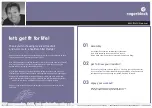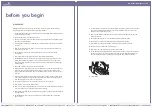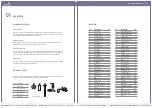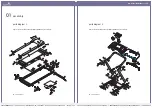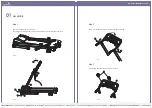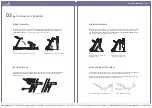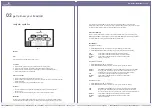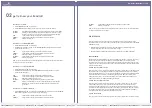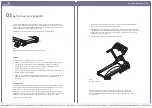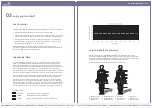
www.rogerblackfitness.co.uk
03
enjoy your workout!
what is exercise?
‘What is exercise’ sounds like a silly question, but did you know that there are four aspects of exercise?
1. Cardiovascular fitness (the fitness level of your heart, lungs, veins and arteries)
2. Muscular strength (the fitness of muscles in your legs, arms, buttocks etc, which are vital to perform
fundamental movements of everyday life, such as carrying your shopping or doing the vacuuming)
3. Muscular endurance (the stamina required by your muscles to be able to do more vacuuming!)
4. Flexibility (the range of movement at a joint where two or more bones meet, to allow you to do
simple tasks easily, like bending your knee to tie your shoes)
Different exercises (and in turn different exercise products) target these aspects of exercise.
For example, a treadmill is good for cardiovascular fitness, whilst a bike is better for muscular strength
and endurance. HOW you train is also vitally important.
cardiovascular fitness
The muscle (your heart) and vital organs (your lungs, veins and arteries) form your cardiovascular
system. Your cardiovascular system is responsible for processing and transporting oxygen to your
muscles. Your heart contracts to pump blood around your body and provide your muscles with the
oxygen they need. As your cardiovascular fitness improves, your heart will become more efficient, being
able to pump blood with fewer contractions. Thus, a slower heart rate usually means a fit heart!
Like any other muscle, you can strengthen your heart by exercising it. This means doing any activity that
makes your heart beat quickly and you breathe deeply. This type of exercise is called aerobic exercise.
How fast should your heart beat during aerobic exercise? Fast enough to reach and stay in its “target
zone,” a range of beats per minute that is largely determined by your age and physical condition.
To make sure your heart is beating in its target zone, you'll need to know how to monitor your heart
rate. The easiest way is to feel the pulse in the carotid artery on either side of your neck, between the
windpipe and the large neck muscles. Count the number of beats in ten seconds, and then multiply that
number by six. This gives you the number of beats per minute. To determine your target zone, consult
the chart opposite. As you exercise, monitor your heart rate and try to keep it within your target zone.
Heart Rate Chart key:
ADVANCED
Sports, athletic conditioning or interval training
FITNESS
Optimal training, aerobic or cardiovascular
HEALTH
Beginner, low intensity with long duration produces fat burning
muscular strength and endurance
Muscles are important for a healthy lifestyle. We MAINTAIN our muscles just by going about our
everyday lives, but to IMPROVE them we need to exercise. The best way to improve muscular strength
and endurance is to perform resistance-based exercises more often. Those focusing on ‘weight’ loss will
be pleased to note that muscular tissue uses more calories than inactive tissue!
Your treadmill will help you to develop primarily lower body muscle groups:
A. Shoulder muscles
B. Pectoral muscles
C. Bicep muscle
D. Abdominal muscles
E. Forearm muscles
F.
G. Calf muscles
H. Trapezius muscles
I.
J. Back muscles
K. Gluteal muscles
L. Hamstring muscles
PDF compression, OCR, web optimization using a watermarked evaluation copy of CVISION PDFCompressor


